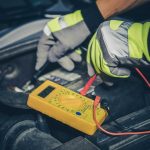As you navigate through the bustling highways and threads of asphalt that constitute our roads, it’s crucial to know what to do if your vehicle unexpectedly breaks down. A car breakdown can be nerve-wracking and dangerous, especially when it happens on a high-speed motorway. By understanding the appropriate steps to take for your safety and the safety of others around you, you can handle this emergency with a level head. This guide details the actions you should take if your car breaks down in traffic, from signalizing your situation to calling for assistance.
Recognizing the signs and preparing to stop
Before your car comes to an abrupt stop on the motorway, it will often give you signs that something is wrong. Perhaps the engine will start making unusual noises, or warning lights on your dashboard will start to flicker. When these signs appear, don’t panic. Instead, start preparing to bring your vehicle to a safe stop.
Additional reading : What are the latest advancements in automotive safety technology?
Begin by scanning your surroundings and assessing the traffic. If possible, aim to guide your car to the far-left lane or the hard shoulder—essentially, as far away from the flow of traffic as possible. Remember to use your indicator lights to signal your intentions to other drivers.
Slowly reduce your speed, but avoid sudden breaks. Rapid deceleration can be dangerous in a high-speed environment like a motorway. As you move to the side of the road, switch on your hazard lights to alert other motorists of your situation.
Have you seen this : What are the optimal driving techniques for fuel economy?
Safely positioning your vehicle
Once your vehicle has been guided to the side of the road, it’s vital that you position it correctly. Your vehicle needs to be visible to other drivers, and you need to be safe while you await assistance.
Position your vehicle as far to the left as possible, with your wheels turned to the left. This ensures that if your vehicle is accidentally hit, it will be pushed away from the traffic, not into it. Remember to put on your parking brake to prevent your car from moving unexpectedly.
Once safely positioned, turn on your sidelights if the visibility is poor or it’s night time. This will maintain the visibility of your vehicle to other drivers.
Alerting others and calling for assistance
Now that your vehicle is safely positioned, it’s time to alert other road users and call for assistance.
Exit your vehicle using the left-hand doors to avoid the flow of traffic and stand well away from your car and the carriageway—preferably behind a safety barrier if there is one. Don’t attempt to place a warning triangle on a motorway due to the high-speed nature of the traffic.
Now, call for assistance. If you have a roadside assistance provider, call them first. If you don’t have one, or can’t get through, dial the emergency services. Provide them with all the necessary details about your location and the condition of your vehicle.
Staying safe while waiting for assistance
As you wait for assistance to arrive, it’s essential to stay safe. Do not attempt to fix the vehicle yourself on the motorway, even if you believe you know what’s wrong. It’s not worth the risk.
Stay well away from the carriageway and your vehicle. If possible, stand behind a safety barrier. Remember, it’s safer to wait outside your vehicle, behind a barrier, than it is to stay in your car.
While waiting, keep an eye on the road. Watch out for any potential dangers and be ready to alert the roadside assistance or tow truck when they arrive.
Reacting to traffic while broken down
Reacting to motorway traffic while broken down is another critical aspect of ensuring your safety.
If your vehicle is causing an obstruction on the road, and it’s safe to move it, try to do so. If you can’t move it, inform the roadside assistance or emergency services about this so they can manage the traffic around your vehicle.
While waiting, remain vigilant and be cautious of other vehicles. Be ready to move quickly if it looks like another vehicle isn’t going to stop or is losing control.
In conclusion, the key to reacting to a car breakdown on the motorway is to remain calm, act with safety in mind, and call for assistance as soon as possible. By following these steps, you can protect yourself and other road users.
Dealing with the aftermath of a breakdown
After you’ve navigated through the initial stages of a breakdown, there are several follow-up actions necessary to rectify the situation.
Firstly, it’s crucial to contact your car insurance company as soon as possible. Inform them about the breakdown and provide details about the incident. If your policy includes roadside assistance or towing coverage, your insurance company will coordinate with the service provider to get your vehicle to a mechanic shop. If your vehicle was hit or damaged while on the roadside, you might need to file a claim.
Documenting the scene is also a significant step. Take pictures of your vehicle from different angles, focusing on any visible damage. These pictures can serve as evidence if there’s a dispute about the incident’s cause or extent of the damage.
While waiting for the tow truck, note down the particulars of your location, time and, if applicable, the details of any other involved vehicles. This information could be crucial when dealing with your insurance company or if a legal issue arises.
Even after the emergency services have left and your vehicle is towed away, continue to remain vigilant of your surroundings. On the national highways, fast-moving traffic and blind spots can still pose a danger.
The role of emergency vehicles during a car breakdown
Emergency vehicles play a crucial role when there’s a car breakdown on the motorway. They are equipped to handle such situations efficiently and ensure the safety of all road users.
When an emergency vehicle, such as a police car or ambulance, arrives on the scene, they will likely use their high beam headlights or other visual signals to alert oncoming traffic of the breakdown. It’s crucial for other drivers to respect these signals and reduce speed or move over to give the emergency vehicle ample space to operate.
If your vehicle is causing an obstruction, the emergency vehicle can help move it to the side road or hard shoulder, reducing the risk of accidents.
Emergency vehicles may also provide first aid or other assistance if necessary. If you or any passengers are injured, immediately inform the emergency services.
In conclusion, dealing with a car breakdown on a high-speed motorway can be a daunting experience. However, by maintaining a level head, following the safety procedures, and relying on the expertise of emergency services and roadside assistance, you can manage such situations effectively. Always keep in mind, your safety and the safety of others is paramount. Therefore, never hesitate to call for professional help when your car breaks down.











